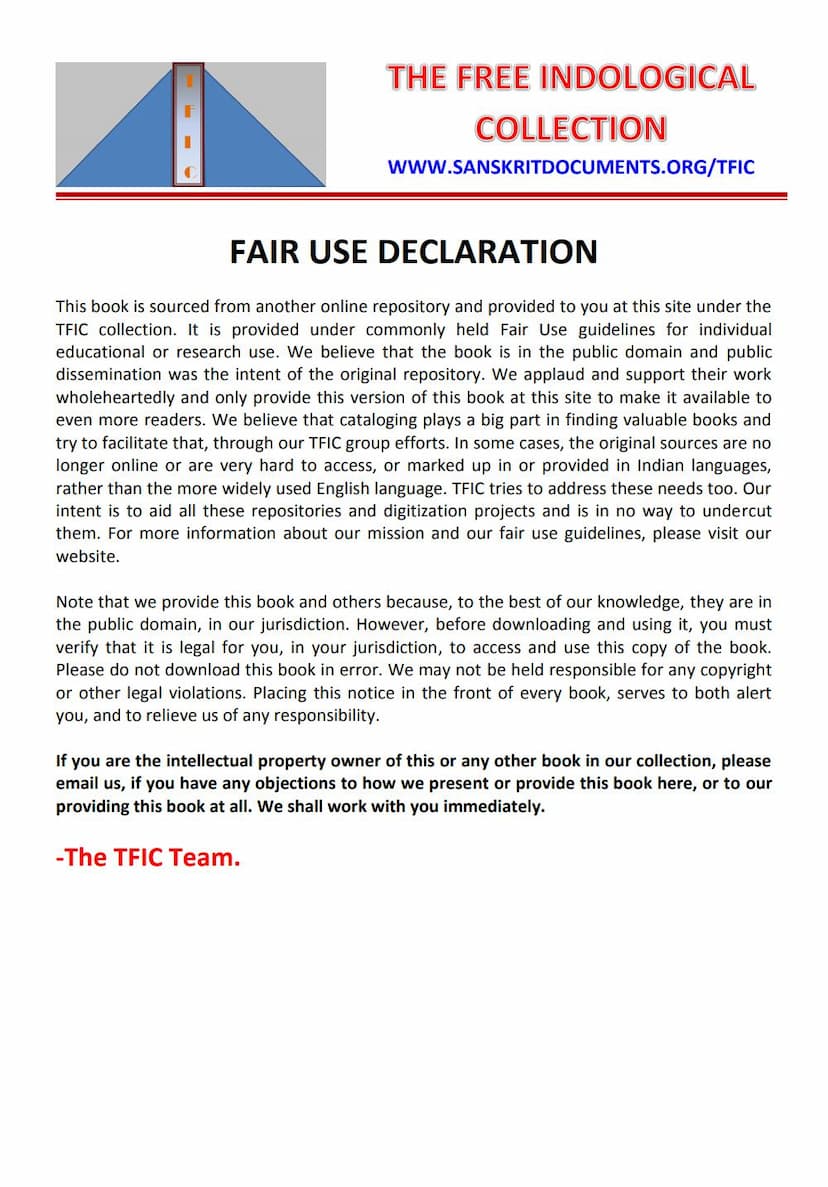This Is Jainism
Added to library: September 2, 2025

Summary
Here's a comprehensive summary of the Jain text "This is Jainism" by C. N. Zutshi, based on the provided pages:
Overall Purpose and Tone: The book aims to clarify common misconceptions about Jainism, particularly those stemming from a Christian perspective (as exemplified by Margaret Stevenson's critique). The author, C. N. Zutshi, seeks to present Jainism as a rational, scientific, and universally applicable philosophical system rather than a dogmatic religion. The tone is informative, persuasive, and aims to dispel ignorance and doubt.
Key Themes and Arguments:
-
Universality of Jainism:
- Jainism is presented as a universal philosophy, not a sectarian religion. Its principles are applicable to all human beings, regardless of their background.
- It offers a comprehensive philosophy of life, detailing man's origin, progress, and ultimate goal, rooted in the idea of the brotherhood of all life.
- It is more a "philosophical thought" than a "dogmatic religion," focusing on reasoned arguments rather than blind faith.
-
Scientific and Rational Approach:
- Jainism is described as a "science" rather than a set of arbitrary rules. Its validity comes from the spiritual experience of its perfected beings (Tirthankaras), not from non-human authority.
- It employs a scientific method of classification, analysis, and accurate understanding to address life's problems.
- The conception of "Godhead" in Jainism is presented as more rational and scientific than the idea of an external creator God, emphasizing that perfection is achieved through self-effort and evolution.
-
Rejection of a Creator God and Focus on Self-Effort:
- Jainism denies the existence of an eternal God as the Supreme Ruler and Creator of the world.
- It asserts that the world is eternal.
- Perfection, liberation (Moksha/Nirvana), and happiness are attained through the soul's own self-effort, purification of thought and action, and freedom from desire, not through divine intervention or grace.
-
The Nature of the Soul and Liberation:
- The human soul (Jiva) is seen as inherently pure, conscious, all-knowing, blissful, and possessing infinite power.
- This natural perfection is obscured by "karmic matter" (Pudgala) attracted through passions and actions, leading to bondage (Bandha) and transmigration (Samsara).
- Liberation is achieved by checking the influx of karmic matter (Samvara) and removing existing karmic matter (Nirjara), leading to the soul's return to its pure, perfect state (Ananta Chatushtaya: infinite perception, knowledge, power, and bliss).
-
Antiquity of Jainism:
- The book argues for the deep antiquity of Jainism, citing scholars and archaeological findings.
- References are made to figures like Lord Nemi Nath and Rishabha Nath, suggesting Jainism predates or coexisted with early Vedic traditions.
- The Indus Valley civilization is presented as potentially having Jain influences.
- Scholars like Dr. S. C. Vidya Bhushan, Prof. Ram Prasad Chandra, and Major General J. G. R. Furlong are quoted to support its ancient origins and distinctiveness.
-
Core Principles and Ideals:
- Ahimsa (Non-violence): This is presented as a deeply scientific principle applicable to everyday life, encompassing non-injury to all living beings in thought, word, and deed. The interpretation reconciles passive resistance with necessary action in emergent circumstances for householders.
- Satya (Truthfulness): Abstinence from lies.
- Asteya (Non-stealing): Abstinence from stealing.
- Brahmacharya (Chastity/Celibacy): Leading a life of sexual abstinence.
- Aparigraha (Non-possession): Non-possession of material things, advocating for trusteeship or renunciation. This is seen as a path to socialism and reducing wants.
- Gun Puja (Recognition of Merit): Reverence for all saints and worthy individuals, regardless of their origin or specific tradition (exemplified by Hemchandracharya's verse).
- Mangala (Seeing Good): Finding good in everything.
- Emphasis on Inner Spirit: The book highlights that the true essence of religion lies in its ethical and moral conduct (the inner aspect), rather than external rituals and forms. Mahatma Gandhi is presented as an example of someone who lived by this inner spirit.
- The concept of Tattvas (Essential Objects of Knowledge): The seven Tattvas (Jiva, Ajiva, Ashrava, Bandha, Samvara, Nirjara, Moksha) form the framework for understanding the Jain path to liberation.
- Focus on Individual Responsibility: Man is responsible for his own actions and their consequences.
- Impersonal Worship: Reverence is given to worthy souls, irrespective of their origin.
-
Jainism's Influence on Modern Civilization:
- The author argues that true civilization involves the culture of the soul, not mere sensualism.
- Jainism, with its principles of self-abnegation and reducing material wants, offers a path to genuine progress, countering the negative effects of modern materialism.
- The ethical framework of Jainism, particularly Ahimsa, is seen as a foundational element that has influenced Indian civilization and even the principles of the Indian Constitution.
Critique of Misconceptions: The book directly addresses and refutes the idea that Jainism denies the brotherhood of man or is atheistic. It argues that the denial of a creator God is a rational stance, and the emphasis on self-effort and the brotherhood of life (including animals) fosters a deeper sense of universal kinship.
Literary Style and Influences: The author uses literary references, particularly from Robert Browning, to illustrate and resonate with Jain philosophical concepts, such as the journey of the soul, the nature of suffering and liberation, and the idea of progress.
In essence, "This is Jainism" by C. N. Zutshi is a defense and explanation of Jainism as a rational, ethical, and universal spiritual path centered on self-effort, non-violence, and the purification of the soul to achieve ultimate liberation and bliss.